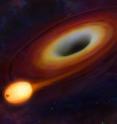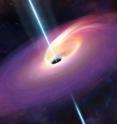Black hole kills star and blasts 3.8 billion light year beam at Earth
Related images
(click to enlarge)
Research led by astronomers at the University of Warwick has confirmed that the flash from one of the biggest and brightest bangs yet recorded by astronomers comes from a massive black hole at the centre of a distant galaxy. The black hole appears to have ripped apart a star that wandered too close, creating a powerful beam of energy that crossed the 3.8 billion light years to Earth. Their research is published today in the Journal Science in a paper entitled "An Extremely Luminous Panchromatic Outburst from the Nucleus of a Distant Galaxy"
The high energy X-rays and gamma-rays persisted at an extremely bright level for weeks after the event, with bright flares arising when further chunks of the star fell into the black hole. The extreme brightness of this event comes from the fact that it illuminated only a small fraction of the sky, pointing a jet of light towards the Milky Way, which was detected at Earth 3.8 billion years after the star was ripped apart.
Dr Andrew Levan, lead researcher on the paper from the University of Warwick "Despite the power of this the cataclysmic event we still only happen to see this event because our solar system happened to be looking right down the barrel of this jet of energy".
The new research paper clearly establishes that the source of this event - (known now as Sw 1644+57) is right at the heart of far away galaxy, 3.8 billion light years away, at a spot which would be in the constellation Draco.
University of Warwick researcher Dr Andrew Levan said:
"The only explanation that so far fits the size, intensity, time scale, and level of fluctuation of the observed event, is that a massive black at the very centre of that galaxy has pulled in a large star and ripped it apart by tidal disruption. The spinning black hole then created the two jets one of which pointed straight to earth."
Source: University of Warwick
Articles on the same topic
- Gamma-ray flash came from star being eaten by massive black holeThu, 16 Jun 2011, 18:36:26 UTC
- X-ray telescope finds new voracious black holes in early universeWed, 15 Jun 2011, 21:34:00 UTC
- Astronomers discover earliest black holes at dawn of universeWed, 15 Jun 2011, 17:36:44 UTC
- Rutgers contributes to findings that black holes were surprisingly common in early universeWed, 15 Jun 2011, 17:36:35 UTC
- Nearby galaxy boasts 2 monster black holes, both activeFri, 10 Jun 2011, 22:32:26 UTC
Other sources
- Black holes dating to the early universe uncoveredfrom LA Times - ScienceSat, 18 Jun 2011, 5:00:21 UTC
- Ultra-Bright Burst of Light Marks the Death Throes of a Star Being Eaten Alivefrom PopSciFri, 17 Jun 2011, 20:30:55 UTC
- Galaxy's Heart Beats in X-Raysfrom Space.comFri, 17 Jun 2011, 16:31:57 UTC
- Rare Sight: Giant Black Hole Devours Star, Fires Beams at Earthfrom Live ScienceFri, 17 Jun 2011, 14:30:30 UTC
- The Hole Picture: Growth of Black Holes and Galaxies Linked from an Early Agefrom Scientific AmericanFri, 17 Jun 2011, 14:30:23 UTC
- ScienceShot: Powerful Jet Being Produced by Star-Eating Black Holefrom Science NOWFri, 17 Jun 2011, 13:50:13 UTC
- Black hole eating star did cause huge blast: reportsfrom CBC: Technology & ScienceFri, 17 Jun 2011, 13:01:03 UTC
- Massive black hole devours starfrom BBC News: Science & NatureThu, 16 Jun 2011, 21:00:35 UTC
- Black hole shreds star, sparking gamma ray flashfrom Reuters:ScienceThu, 16 Jun 2011, 20:50:06 UTC
- Gamma-ray flash came from star being eaten by massive black holefrom Science DailyThu, 16 Jun 2011, 20:30:36 UTC
- Black hole kills star and blasts 3.8 billion light year beam at Earthfrom Science DailyThu, 16 Jun 2011, 20:30:34 UTC
- Unusual Celestial Event Was Black Hole Swallowing a Starfrom NY Times ScienceThu, 16 Jun 2011, 20:20:09 UTC
- Black Hole Caught Eating a Star, Gamma-Ray Flash Hintsfrom National GeographicThu, 16 Jun 2011, 20:00:27 UTC
- Giant black hole eats star, fires beams at Earthfrom CBSNews - ScienceThu, 16 Jun 2011, 20:00:20 UTC
- Unusual gamma-ray flash may have come from star being eaten by massive black holefrom PhysorgThu, 16 Jun 2011, 18:30:51 UTC
- Rare Sight: Giant Black Hole Devours Star, Fires Beams at Earthfrom Space.comThu, 16 Jun 2011, 18:30:21 UTC
- AUDIO: The oldest black holes in the universefrom BBC News: Science & NatureThu, 16 Jun 2011, 12:00:44 UTC
- Black hole growth, galaxy formation linkedfrom UPIThu, 16 Jun 2011, 7:00:24 UTC
- Black hole growth, galaxy formation linkedfrom UPIThu, 16 Jun 2011, 1:20:35 UTC
- X-ray telescope finds new voracious black holes in early universefrom Science DailyWed, 15 Jun 2011, 23:30:24 UTC
- Giant Black Holes Found at Dawn of the Universefrom National GeographicWed, 15 Jun 2011, 21:00:21 UTC
- Astronomers discover earliest black holes at dawn of universefrom Science DailyWed, 15 Jun 2011, 19:30:37 UTC
- X-ray analysis technique helps scientists determine that black holes grew voraciously in young galaxiesfrom Science DailyWed, 15 Jun 2011, 18:30:29 UTC
- NASA's Chandra finds massive black holes common in early universefrom Science DailyWed, 15 Jun 2011, 18:30:25 UTC
- Black holes found to exist since dawn of timefrom CBSNews - ScienceWed, 15 Jun 2011, 18:30:20 UTC
- Secrets of Earliest Black Holes Found in Ancient Galaxiesfrom Space.comWed, 15 Jun 2011, 17:30:46 UTC
- Most distant black holes ever found reveal secretsfrom CBC: Technology & ScienceWed, 15 Jun 2011, 17:30:29 UTC
- Bblack holes were surprisingly common in early universe: studyfrom PhysorgWed, 15 Jun 2011, 17:00:37 UTC
- Twin Supermassive Black Holes Found At Nearby Galaxy's Heartfrom PopSciMon, 13 Jun 2011, 22:00:24 UTC
- How Do Black Holes Form?from Space.comMon, 13 Jun 2011, 18:00:24 UTC
- Which Stars Form Black Holes?from Space.comMon, 13 Jun 2011, 18:00:23 UTC
- Nearby galaxy boasts two monster black holes, both activefrom Science DailySat, 11 Jun 2011, 0:30:27 UTC
- Monster Black Hole Twins Found Inside Galaxy's Bellyfrom Space.comFri, 10 Jun 2011, 22:30:18 UTC
- Our Galactic Neighbor Harbors a Second Black Holefrom Space.comFri, 10 Jun 2011, 20:00:32 UTC
- Nearby galaxy boasts two monster black holes, both activefrom PhysorgFri, 10 Jun 2011, 19:00:29 UTC


